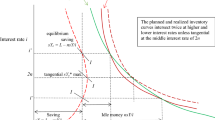Abstract
The standard utility-maximizing model of the trade union in a closed economy is reformulated for an environment where economic integration is under way or expected to occur soon. In the (European) realistic setting of union-dominated labor markets, domestic wages are shown to be affected by labor market developments abroad. This article provides an explanation of the international transmission of inflation and disinflation
Similar content being viewed by others
References
Calmfors, Lars (1993) “Centralization of Wage Bargaining and Macroeconomic Performance-A Survey.” OECD Economics Studies 21: 161–191.
Calmfors, Lars (1982) “Employment Policies, Wage Formation and Trade Union Behavior in a Small Open Economy.” Scandinavian Journal of Economics 84(2): 345–373.
Calmfors, Lars and Henrik Horn (1985) “Classical Unemployment, Accommodation Policies and the Adjustment of Real Wages.” Scandinavian Journal of Economics 87(2): 234–261.
Classen, Emil Maria and Pascal Salin (eds.) (1972) Stabilization Policies in Interdependent Economies. Amsterdam: North-Holland.
Feldstein, Martin and Charles Horioka (1980) “Domestic Savings and International Capital Flows.” Economic Journal 90: 314–329.
Gylfason, Thorvaldur and Assar Lindbeck (1986) “Endogenous Unions and Governments: A Game-Theoretic Approach.” European Economic Review 30(1): 5–26.
Kouri, Pentti J.K. (1978) “Profitability and Growth in a Small Open Economy.” In Assar Lindbeck (ed.) Inflation and Employment in Open Economies. Amsterdam: North Holland, 129–142.
Kouri, Pentti J.K and Michael G. Porter (1974) “International Capital Flows and Portfolio Equilibrium.” Journal of Political Economy 82(3): 443–467.
Laidler, David E.W. and Michael Parkin (1975) “Inflation: A Survey.” Economic Journal 85: 741–809.
Markowski, Alek and Parameswar Nandakumar (1993) “A Long-Run Equilibrium Model for Sweden.” Working Paper 32, National Institute of Economic Research, Stockholm.
OECD (1970) Inflation: The Present Problem. Paris, OECD.
Oswald, Andrew J. (1982) “The Microeconomic Theory of the Trade Union.” Economic Journal 92: 567–595.
— (1985) “The Economic Theory of the Trade Union: An Introductory Survey.” Scandinavian Journal of Economics 87(2): 160–193.
Sampson, Anthony A. (1983) “Employment Policy in a Model with a Rational Trade Union.” Economic Journal 93: 297–311.
Soderstrom, Hans T. (1985) “Union Militancy, External Shocks and the Accommodation Dilemma.” Scandinavian Journal of Economics 87(2): 335–351.
Author information
Authors and Affiliations
Rights and permissions
About this article
Cite this article
Batavia, B., Nandakumar, P. Economic Integration and Union Power. Open Economies Review 13, 175–182 (2002). https://doi.org/10.1023/A:1013925331572
Issue Date:
DOI: https://doi.org/10.1023/A:1013925331572




